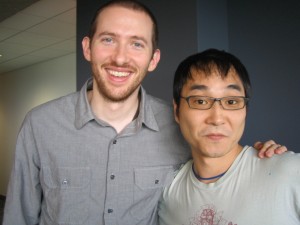We have decided to join forces with the rest of Japan Society! Continue to read about IN on the Japan Society blog.
CONGRATULATIONS to the Kyomachiya Innovators group in Japan!!!
Today, the World Monuments Fund announced the 2010 Watch List and the machiya, traditional Japanese townhouses, was selected along with 92 other at risk cultural heritage sites from around the world. The selection will play a critical role in the Kyomachiya Innovators’ mission to inform and teach the world about the cultural and historical value of the machiya.
Posted in Uncategorized | Tagged Kyomachiya Innovators, Kyoto townhouse, machiya, World Monuments Fund Watch List | Leave a Comment »
Innovators Network member and anime scriptwriter Dai Sato was in New York to give a two-week summer immersion workshop for high school students at Japan Society. Dai took some time out of his busy schedule to talk with Japan Society about his creative process. In this video, Dai muses about his “dream script,” discusses new features in Eden of the East, an anime series as of yet unreleased in the U.S., touches on the influence of authors Philip K. Dick and Haruki Murakami on his work, offers advice for future scriptwriters, and explains a few of the perception gaps between American and Japanese viewers regarding the TV series Ghost in the Shell: Stand Alone Complex.
Dai’s scriptwriting credits also include Cowboy Bebop, Freedom, and Wolf’s Rain.
Posted in Dai Sato, Uncategorized | Tagged anime, Cowboy Bebop, Dai Sato, Eden of the East, Ghost in the Shell: Stand Alone Complex, Haruki Murakami, Japan Society, Philip K. Dick, screenwriter, Storyriders, U.S.-Japan Innovators Network, Video, Wolf’s Rain | Leave a Comment »
 Innovators Network member Hiroshi Tasaka’s poetic The Five Laws to Foresee the Future: 12 Paradigm Shifts that will Happen in the Future of Human Society (未来を予見する「5つの法則」) is out in English. Tasaka-san’s philosophical insights into the future of work, life and society make for rivetting reading. For those who may have missed it, Tasaka-san gave a talk at a joint Japan Society- New School forum, “Beyond Web 2.0: How Technology will Change the World.”
Innovators Network member Hiroshi Tasaka’s poetic The Five Laws to Foresee the Future: 12 Paradigm Shifts that will Happen in the Future of Human Society (未来を予見する「5つの法則」) is out in English. Tasaka-san’s philosophical insights into the future of work, life and society make for rivetting reading. For those who may have missed it, Tasaka-san gave a talk at a joint Japan Society- New School forum, “Beyond Web 2.0: How Technology will Change the World.”
Posted in future, homelessness, U.S.-Japan Innovators Network, Uncategorized | Tagged Hiroshi Tasaka, Innovators Network, Japan Society, Paradigm shifts, The Five Laws to Foresee teh Future, The New School, U.S.-Japan Innovators Network, Web 2.0 | Leave a Comment »
While on Miyakejima, we were introduced to a husband and wife team who own a small gift shop on the island. They’ve endured quite a bit, including losing their home and first shop because of a volcano many years ago, only to have to leave Miyakejima after the 2000 volcano eruption for 4 1/2 years. He and his wife returned however, and have opened a new shop. After picking up a few gifts for friends and family back home, the gentleman agreed to sit down with us and share his story.

Before he evacuated, he had the foresight to bring his collection of photographs of Miyakejima. An amateur photographer, he had taken beautiful photos of the island’s natural beauty, including sunsets, plants and the ocean, going back decades. While in Tokyo, he had a number of photos printed as postcards, and sent them to many of his friends and neighbors from Miyakejima. He made a special effort to send these postcards of home to many of the senior citzens. Word spread about the postcards, and other residents requested to be on his mailing list.
The postcards helped this gentleman re-create his community in Tokyo, but in a completely different way. Those who received his postcards told him that they waited in anticipation to receive the next card, and it played a tremendous role in keeping their spirits, and their hopes, high. By the end of his time in Tokyo, he sent thousands and thousands of cards, at his own expense.
We were all so impressed with how what started as a simple gesture by just one person helped to create a real sense of community hundreds of miles from home and provided so many people with hope and happiness.

Posted in Uncategorized | Tagged Learning from Disaster, Miyakejima | Leave a Comment »
After the exchange program, the Learning from Disaster (see earlier posting below), finished, a small group had the priviledge of visiting Miyakejima. After an overnight boatride, we spent a day and half visiting two schools, meeting with staff and members of the House of Wind (Kaze-no-Ie), visiting Ako port and meeting with fishermen, driving up the volcano to an observation area to look at the volcano’s damage up close, and meeting with citizens and local government officials.
Miyakejima is beautiful, and the damage from the 2000 volcano eruption, and an earlier eruption, caused great damage. One of the things we were so impressed with was the great spirit and sense of hope expressed by everyone we met with, young and old.
Here are some photos from the visit.
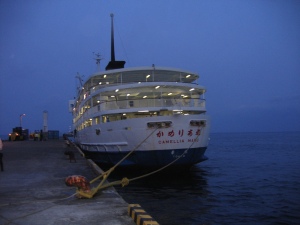
The ship from Tokyo to Miyakejima
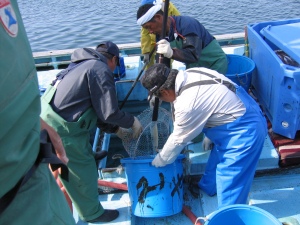
Fishermen unloading the day's catch
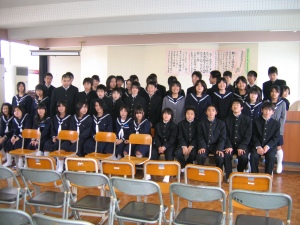
Junior high school students
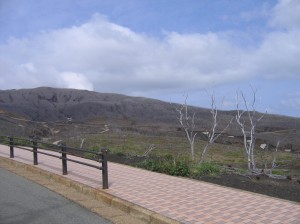
The road up Miyakejima's volcano

Richard McCarthy presenting Mayor Hiroyasu Hirano with a market umbrella
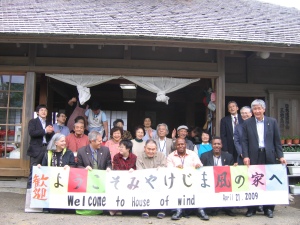
House of Wind
Posted in Uncategorized | Tagged House of Wind, Learning from Disaster, Miyakejima | Leave a Comment »

